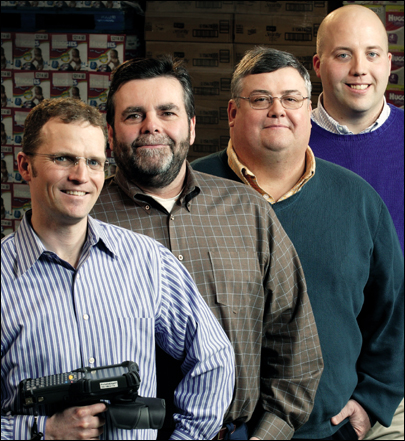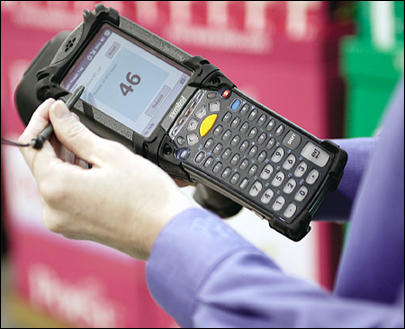Product promotions are a big deal for most consumer packaged goods companies, especially in the United States. In many cases, the money spent on securing premium floor or shelf space for special displays in a retail store, advertising the products, paying merchandising agents to check that the displays are out and other costs can equal or exceed the cost of manufacturing the product. But all too often, the displays aren’t out in time, and both the manufacturer and the retailer lose out on potential sales. Thanks to RFID technology, this might soon change.
Kimberly-Clark, the global health and hygiene company based in Irving, Texas, has been testing radio frequency identification’s ability to improve the execution of its in-store promotions. The company worked with OATSystems to conduct a pilot program with Wal-Mart to track and manage promotional displays of its Depend and Poise incontinence products in hundreds of stores. The result: improved execution of in-store promotions by more than 20 percent at RFID-enabled stores.
Several years ago, K-C assembled a brain trust to figure out how the company could take advantage of RFID technologies in the short, medium and long term. Mike O’Shea, director of auto-ID sensing technologies, leads the RFID technology team responsible for developing solutions, evaluating hardware and software, and testing it before it is deployed. Phil Therrien, RFID implementation manager, is in charge of the business team representing the business managers who will use the technology in
K-C’s facilities. Rick Polzin, senior RFID specialist, manages the operational teams to make sure the data captured by RFID systems can be used to improve the way K-C does business. Together, they found potential solutions to some of the challenging issues related to tagging in-store promotional displays either at K-C manufacturing facilities or third-party packaging locations without any RFID infrastructure. This is the story of how they did it.
The RFID brain trust saw an opportunity to increase retail sales by improving the store execution of promotional displays and reducing shelf-level out-of-stocks. “We recognized that we were increasing our spending on trade promotion activity with our key retailers,” says Therrien. “The expenditure for these promotions was becoming a larger line item on our profit and loss statement, and there was a sense that we weren’t experiencing the level of ROI on our in-store promotions we required because there were gaps in execution. It really was a shared opportunity for us and our retail partners, because when execution is less than perfect, we both lose those sales dollars.”
K-C’s sales teams negotiate the details of each promotion with the retailers’ buying teams. Together, they determine which stores will participate in a promotion, where the promotional displays will be in the stores, and the dates on which the displays will be brought out and removed. But tracking whether the displays have been delivered and brought to the sales floors on time has been a challenge for both K-C and its retail partners.
Displays take many forms—from pallet units to clip-strips attached to store shelving. The displays can promote a single stock-keeping unit or several SKUs. RFID provides new information on the movement of the display from the back room of the store to the sales floor. Previous methods relied on physical inspections or point-of-sale data to detect promotional display execution. Both options are inadequate: It’s expensive to do physical inspections at every store in a national chain, and POS data doesn’t distinguish between a product picked from a display and the same SKU picked from a shelf.
Retailers usually scan bar codes on displays when they are received into inventory at the back of the store. Most don’t share any data with their suppliers, so manufacturers don’t know if or when a promotional display arrived. But even if retailers provided that information via a secure extranet, suppliers have no way of knowing whether the displays are sitting forlornly in the back room or are being showered with attention from consumers in a highly trafficked area of the store.
K-C uses a retail business services company called Crossmark to conduct random checks at stores to confirm that displays and product have been merchandised properly (that is, brought out to the store floor and positioned correctly). When Crossmark representatives don’t find the displays on the floor, they can alert the retailer to bring them out. But this spot-check approach has its limits because the merchandisers can’t hit every store or check on every SKU.
K-C’s brain trust realized that RFID could add a new level of visibility. If a store had an RFID infrastructure—interrogators installed at the back of the store and between the back room and the retail floor—K-C could tag displays and, using the data supplied by the retailer, see in near-real time when the displays arrived at the stores and were brought out to the floor.
In 2005, K-C ran a couple of pilots in which it mailed tags based on EPCglobal’s Electronic Product Code standard to a contract packager assembling and packing displays, and had it apply the tags to the displays. But some of these tagged displays never showed up in the data supplied by the retail partner, perhaps because the tagged displays went to a store without RFID interrogators. K-C could have solved the issue by routing the promotional displays to a K-C RFID-enabled distribution center, where it could encode and apply the RFID tags and then track them as they were sent to the retailer, but that would have been inefficient and incurred additional shipping costs.
Another challenge was K-C didn’t have effective processes or robust RFID data analytics software for analyzing the RFID data it was getting back from its retail partner. “We were collecting read data and dumping it into Microsoft Excel and then doing our own analysis of how well we executed,” says Therrien. “Once you got past 10 to 15 stores, it got a lot harder to manage the data.”
K-C solved that issue by turning to software provider OATSystems, which had developed applications that use RFID data to drive business value. K-C purchased an enterprise license for OATSystems’ OATaxiom and OATxpress applications. “That software platform was put in place in 2006,” says Therrien. “It really started to mature and meet our needs as our retail partner scaled up the number of stores with the RFID infrastructure.”
RFID on the Road
But K-C still had to solve the challenge of how to tag goods—either displays or pallets and cases—at facilities without RFID tagging infrastructures; the company needed to support retail pilots outside of the Texas, Oklahoma and Arkansas area, where K-C doesn’t have RFID-enabled DCs. A possible solution came to Therrien and Polzin on a business trip to see one such retailer.
“We said we really need a way to take the business processes and software that we use in our DCs and put it in a briefcase and bring it on the road,” says Therrien. “Rick came back and organized a meeting with our RFID technology and IT support teams to discuss the feasibility of developing an ‘RFID-in-a-briefcase solution.’ The team was excited by the concept and went to work trying to find the devices and software revisions that were necessary to bring it to reality. The primary requirement was that the solution must work in an environment where there is often no Internet connection, no wireless local-area network and no access even to power.”
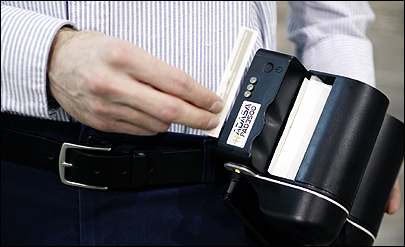
Daniel Bowman, one of the IT hardware and network specialists in K-C’s RFID lab, looked at the issue from a hardware and networking perspective. The challenge would be connecting the laptop to a small RFID printer to encode the EPC tags and to a handheld RFID interrogator that would read the applied tags and verify that the right EPCs were put on the displays. Bowman found a wireless access point made by Linksys that could be plugged into a computer’s USB port to create a wireless bubble, even in a facility with no Internet access.
But there were still a number of issues that needed to be resolved. If K-C wanted to track one-off promotions, the mobile solution would not always be used at the same location. One week it might be used in Pennsylvania to tag a Kleenex brand display, and the next week it might be used in Wisconsin to tag a Huggies brand promotion. “We needed to be able to configure the software so that it would report back to us based on different locations,” says Therrien, “so that the orders would flow from the correct shipping location.”
Robin Krisher, software and systems specialist on K-C’s RFID support team, worked with OATSystems to create and test a version of the Xpress software that could be preconfigured with information about the facility at which it would be used. The goal was to develop a simple user-interface screen. “We used the OATxpress platform to develop what we call the OAT Mobile Tag solution,” says Paul Cataldo, OAT’s VP of marketing and product management. “It gives the users [the contract packagers] just what they need and doesn’t overwhelm them.”
When K-C receives an order from a customer requiring RFID labeling, its legacy system automatically transfers the order to the Axiom software. K-C configured Xpress on a laptop, so the EPCs related to that order would automatically flow down to the laptop, where they could be sent to an encoder that would write the EPCs to the tags. Then a handheld device would be used to read the tags and verify they were put on the displays.
The data from the handheld device had to flow back to the laptop and be uploaded to Axiom, so K-C could generate an advance shipping notice (ASN) to send to its retail partner, which would let the retailer know which displays were coming and what the EPCs on them would be. Since displays are sometimes assembled and packed by contract packagers with no Internet connectivity, the “Portable Edge” solution, as it became known within K-C, had to be able to capture information within the facility and then transfer it back to Axiom the next time the laptop was connected to the Internet.
Another issue was finding an RFID printer small enough to ship around the country. O’Shea’s RFID team began looking for hardware that could be shipped to a remote location to encode, apply and verify tags. There were a number of handheld RFID interrogators that could be used to read the tags after they were applied; the challenge was finding a small device that could encode RFID tags.
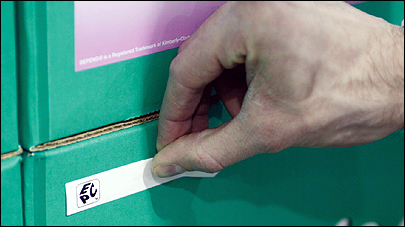
Gary Madsen, a member of O’Shea’s RFID team, found a possible solution—the PAD3500, a wearable RFID encoder made by a startup called ADASA. Madsen arranged a demonstration of the encoder, and afterward ADASA sent a test model to K-C for development. The PAD3500, which can be worn on a belt, is comprised of a cartridge that holds a roll of up to 500 1-by-4-inch RFID inlays and a battery-powered RFID interrogator made by RFID systems developer SkyeTek. It was originally designed to work with reusable tags.
“Shortly thereafter, I met [ADASA founder Clark McAllister] at RFID Journal LIVE! in Las Vegas last May,” says Therrien. “He told me about how he thought it could be used. I said: ‘We have a different spin for you, something you probably haven’t thought about yet.’ We brought him to our RFID lab and showed him our RFID-in-a-briefcase concept.”
K-C’s Bowman worked with OAT to make sure the Xpress software could run on a laptop securely and communicate with the PAD3500 so it could encode tags remotely. He developed a simple interface that would let the user in the remote facility switch from operations mode, where data is sent to and from the ADASA encoder and to and from a handheld interrogator made by Symbol Technologies (now Motorola’s Enterprise Mobility Business), to data-synchronization mode, during which the verified tag reads are automatically sent back to K-C’s Axiom software.
OAT developed interfaces to the Symbol and ADASA mobile devices, so Xpress could send data to and receive data from the devices. It also developed a version of Xpress that uses Microsoft’s SQL Server Express, a database with a smaller footprint, which would make the software run more efficiently on the laptop.
Taking RFID to the Edge
The solution was tested extensively in K-C’s RFID lab to make sure the connectivity between the laptop and the portable devices was effective and to ensure that people in the field wouldn’t run into issues. The system was deployed in mid-2006.
K-C runs a regular promotion for its Depend and Poise incontinence products with Wal-Mart every month. K-C ships pallet-size displays made up of stacked cardboard trays full of different types of the products. These displays usually sit at the end of an aisle in a high-traffic area of the store. K-C decided to track these promotions because they are ongoing, and it could use the RFID data to correct issues in the supply chain and improve the execution of in-store promotions. And that is exactly what it has done.
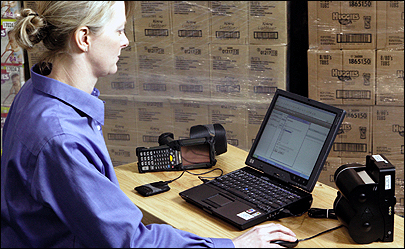
About two weeks before a promotion starts, K-C flags the customer orders in a legacy business system, and the orders flow to Axiom as orders to be RFID-labeled. Each laptop—K-C has three Portable Edge solutions—is configured for the location where the displays will be shipped from, and all the details of that order are downloaded to the laptop. The laptop, handheld and wearable encoder are shipped to the location (it can be either a K-C facility without an RFID tagging system or a third-party location).
When employees at the location where the displays will be tagged bring up the Xpress software on the laptop, they see all the promotional displays that are part of that order. The software generates one tag for each display. Workers apply the tags and use the handheld to record and associate the tags with the promotional displays in the order. When the laptop is connected to the Internet, all the read data is uploaded to Axiom and transferred to the retailer in an ASN.
When Wal-Mart receives the displays, it reads the tags and passes the information back to K-C via an AS2 data feed. The RFID data is in an XML format that includes information about where each tag was read (which store, at the back of the store or as it was moving to the retail floor). K-C then uses Axiom to analyze the read data from the hundreds of RFID-enabled stores and measures execution.
Axiom has reporting tools that show, for instance, that of 87 tagged displays shipped to arrive at stores by Feb. 1, 85 were received. The software also shows that 60 displays are on the sales floor and 25 are in the back room. “We start running this from the time we ship the displays to the customer through the end of the promotion,” says Polzin. “We get a quick picture of execution.”
Even though it’s not possible for POS data to differentiate between products in the display and the same product on the shelf because they have the same UPC, the Axiom reports can use POS data to show the increase in sales achieved in stores when the displays are properly merchandised.
The system has given K-C a level of visibility that it never had before. The company has used the RFID data to solve some challenges it has had with delivering product and display materials to a facility for assembly and packing. “We found that some of the execution issues with our in-store promotions started right at the beginning in the promotion planning phase,” says Therrien. “We’ve tightened up those issues and haven’t seen any of them in the last five or six months.”
K-C also learned there are very different levels of execution within the same retail chain. Some stores get the displays out on time every time, and others get them out and then take them back to the storeroom.
“Some stores were taking the displays back and forth from the back of the store to the retail floor, which means they were using the displays to replenish the shelves, which wasn’t the plan,” says Therrien. “When we investigated, we found that displays didn’t fit in their aisles. Store formats are not as uniform as we’d always like them to be, so we either need to redesign the displays for those stores or just ship them cases, and save the cost of having third parties assemble, fill and ship the displays. This information is new for the retailer as well, so they are learning along with us.”
K-C has been sharing the data with its retail operations teams and merchandising agents, who are responsible for working with Wal-Mart to make sure promotional displays and products get to the retail floor on time. “We’ve been able to improve execution against critical milestones by 20 percent from the baseline of where we were four to five months ago,” says Therrien. “We need more data to determine the exact impact, but early anecdotal evidence indicates that improved execution in the RFID-enabled promotion displays has the strong possibility of leading to increased sales. That’s the business case for RFID right there.”
Displaying the ROI
Tagging displays is cost-effective because the cost of each tag (about 20 cents) is minuscule compared with the hundreds of dollars in sales value of the promotional display. “We want to leverage as much of that RFID-enabled store network as we can, because it doesn’t cost that much to do, relative to the cost of the display, and we’re getting an early win today,” says Therrien. “We are also able to learn more to drive more value over time.”
There is still room for improvement. Some displays get to the retail floor on time only about 70 percent of the time, according to Polzin. RFID should help improve that, as K-C develops new and better business processes to act on the data. The Axiom software stores contact information for Crossmark, and it can send reports on the execution of promotions to Crossmark representatives in specific districts so they can visit stores based on their performance.
“We’re just starting to scratch the opportunities with Crossmark,” says Polzin. “They have schedules to go to specific stores on specific days. It doesn’t match these events, so we are trying to get more focus on these activities and adjust the schedules. We need to use the data to change the processes to achieve even greater success.”
The system is paying off for K-C in another way. Wal-Mart is eager to work with the company on promotions because of the visibility it gets from the tagged displays. “It’s been a win for us in the buying office,” says Polzin. “It’s gotten us additional promotion and distribution that we might not have gotten had we not been a leader in using RFID technology. The retailer’s buyers see it as less risky in participating in promotions with us because they can see and measure the results more accurately.”
Going forward, K-C would like to simplify the Portable Edge system by eliminating the laptop and running Axiom on the handheld device. When entire retail chains have installed RFID infrastructure, K-C envisions eliminating the manual tagging of displays. Instead, it would embed the tag in the display itself. Eventually, K-C hopes contract packagers will install portal interrogators at their facilities, because that would enable K-C to better track the display materials and products sent to the contract packager.
Whether displays are tagged using the Portable Edge system or hardened RFID installations, Therrien believes that RFID will be the tool that enables K-C and its retail partners to work together to continuously improve the execution of in-store promotions. He envisions using RFID to automatically collect data that enables K-C and retailers to measure and fine-tune performance.
K-C is excited about the opportunity the Portable Edge and OAT’s software has created. “With this solution, we can RFID-enable an in-store promotion from any shipping node, and we have a great tool for automatically analyzing the data,” says Therrien. “By clicking a button, we can see what’s happening and instantly share that with all the folks that will be impacted. We’re going to leverage this in 2007 as much as we can.”
Photographs by Scott White

